ChatGPT is making its presence felt in classrooms. Here's how schools in Singapore are harnessing it
With a generative AI chatbot like ChatGPT, the temptation to use it to write the perfect essay is real. CNA finds out how teachers in Singapore steer students away from plagiarism and towards self-directed learning.
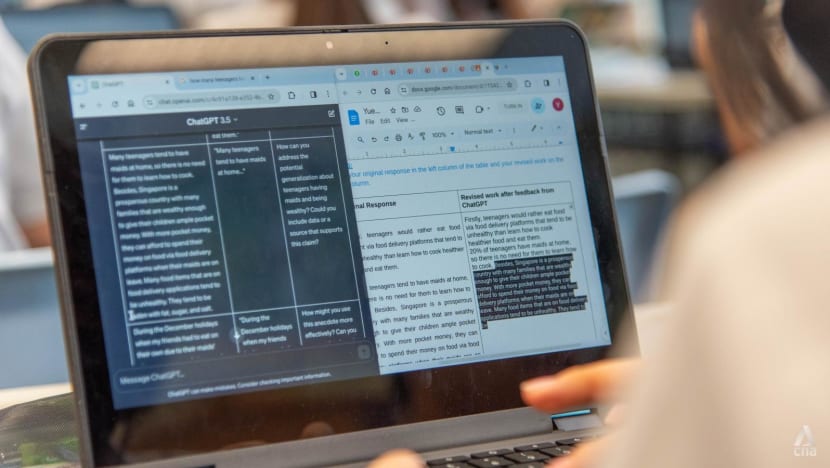
A Manjusri Secondary School student uses ChatGPT to revise and review her work as part of a class activity on Jan 31, 2024. (Photo: CNA/Eugene Goh)

This audio is generated by an AI tool.
SINGAPORE: Secondary 2 students at Manjusri Secondary School had a new English teacher last month.
When the students handed in their work, the teacher could attend to them all at the same time and simultaneously give each student personalised feedback. The teacher even posed each of them different questions to help them revise and improve their work.
Obviously, a human teacher cannot be in more than one place at one time. But ChatGPT can.
In the English lesson for Secondary 2 G3 students that CNA attended on Jan 31, students asked ChatGPT for feedback on a paragraph that they had each written. The paragraph was based on three types of persuasive appeals – pathos, ethos and logos – that they learnt in a previous lesson.
Before starting the exercise, (human) English teacher Erica Reyes Rodriguez took them through the lesson objectives and asked: “Why do we ask ChatGPT to give us feedback through questions instead of asking it to edit our work for us?”
A few students already knew the answer: “So that we can learn how to improve on our own.”
Pleased with the response, Ms Rodriguez reminded the 13- to 14-year-olds that the questions from ChatGPT were meant to help them further their thinking.
The students were given specific prompts to key into ChatGPT to set the tone for the feedback.
“You are a master teacher teaching English in Singapore for Secondary 2 Express students. I will provide you with details about my task, and it will be your job to respond with feedback to my answer,” the first prompt read.
Students asked for feedback through metacognitive questions – focused on reasoning and thinking skills – to help them revise their drafts.
Students also told ChatGPT about the topic: To persuade others to agree or disagree that teenagers are careless with their diet. They asked the chatbot to present the information in a table, highlighting specific sentences that need revision and questions that will improve their work.
Ms Rodriguez and Ms Faith Ong, another teacher who joined in to observe the lesson, left the students to their own devices but occasionally checked in on their progress. After they got their respective questions from ChatGPT, students were told to choose ones that addressed an area of weakness in their original answer or provided something specific to work on.
The students then picked out two questions they wanted to use to improve their original paragraphs and had to justify why they chose them, before rewriting their work.
Enzo Sembiring Kembaren, 13, who told a personal story of adding extra salt to his fast-food meal, picked: “How can you enhance the emotional appeal of your personal experience to make it more relatable and impactful to your readers?”
This question would help improve his story and increase the impact on a teenage reader, he thought.
Enzo used this question to rework his draft, going into deep detail about how he could feel his heart pumping like a jackhammer and poison flowing to his brain, a far more dramatic retelling than his original piece. His classmates chortled at the additional details.
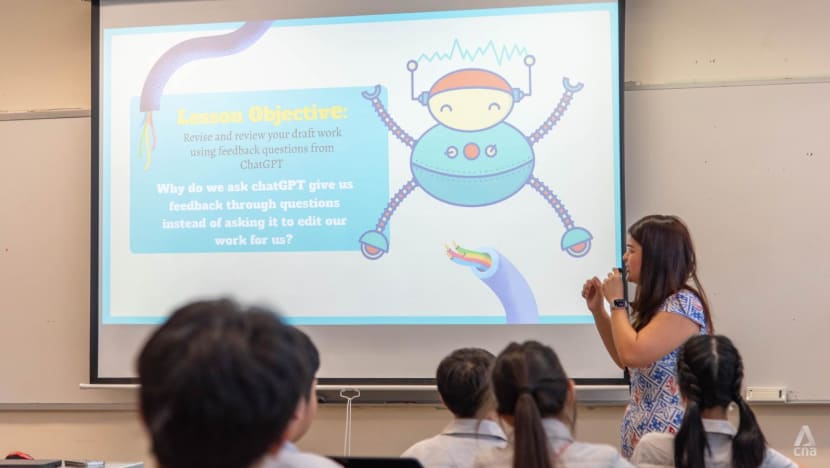
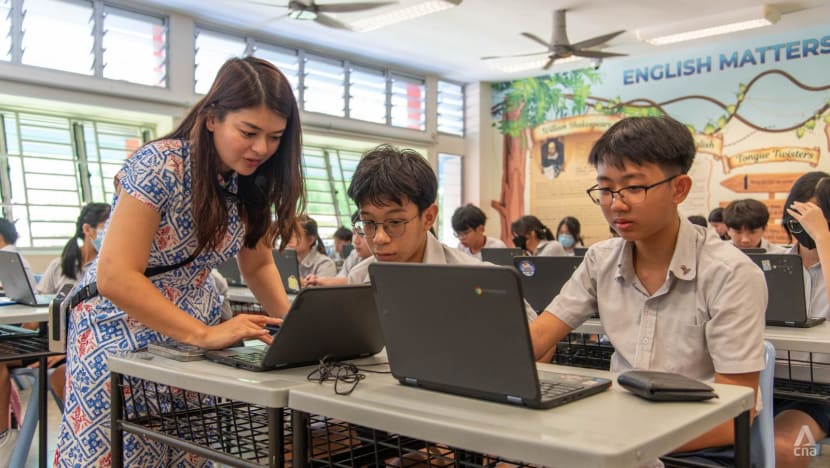
"YOU NEED TO USE YOUR OWN BRAIN"
As the class went on, it was clear that some students were more familiar with ChatGPT than others. Some needed more help from the teachers to get the chatbot to give them their desired results, while others were able to help their classmates with troubleshooting.
Even though most of the students seemed to embrace the use of ChatGPT in class, some of them had doubts.
Thirteen-year-old Roxette Tan first came across ChatGPT on TikTok, watching videos of kids using it to complete their math homework.
“So I thought ChatGPT was very bad for you. Then I told my mum about it, and she told me, don’t use ChatGPT because you need to use your own brain.”
Enzo and his classmate Caelen Ng, also 13, admitted that they had the same impression of ChatGPT, and did not know that it could provide feedback through questions.
“I thought it’s just like, you ask them a question and it’ll just give you a direct answer,” said Caelen.
Caelen thought he would prefer to receive feedback from a human teacher, since ChatGPT is not based on an educator from Singapore.
But after the lesson, he found that most of the responses were similar to what his teacher would have said, and said his opinion on ChatGPT has changed.
“It might be because of my own personal bias but I still really like asking a teacher because I think the teacher still has better opinions than the AI,” Roxette said, adding that she found some of the questions too vague to be helpful.
But Enzo offered a different opinion – ChatGPT might be slightly better than teachers in some situations because human teachers also have their own opinions based on their personal experiences.
“You could ask for statistics or emotional (descriptions), and they could use the data from their network or stories that people posted online, and ChatGPT could use it in their response to you.”
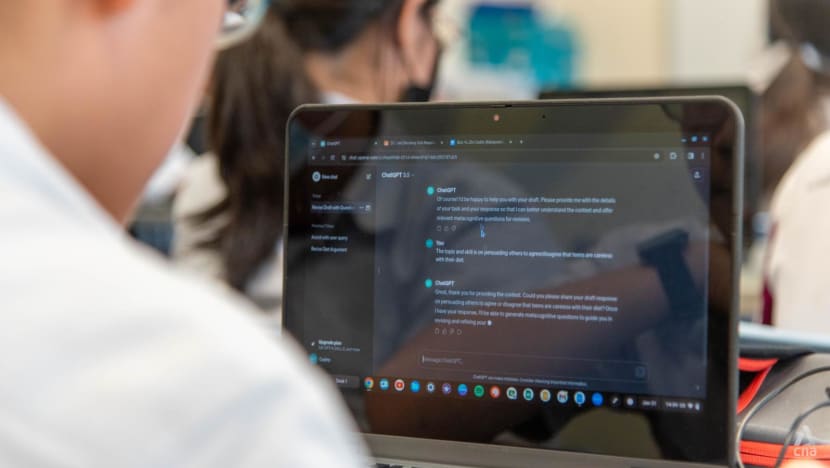
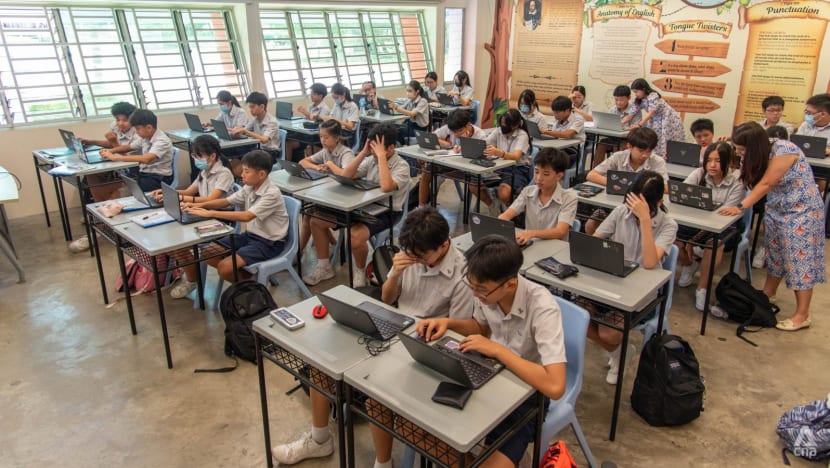
TEACHING AI LITERACY
When Ms Rodriguez first learnt about ChatGPT, she realised she could use it to quickly create teaching resources. She discussed the chatbot with her colleagues, including Ms Ong, and they came up with ideas on how to teach students about it.
“It’s something that they already kind of know about, but they don’t know how to grapple with it,” she added.
They thought it was important to teach the students AI literacy. Teachers come up with the exact prompts used in class according to a “prompt recipe” created by Ms Ong and her team, which took months of thinking and experimentation.
“In allowing them to use ChatGPT in a classroom setting, we are able to create that learning environment for them to use it in a legitimate way, in an ethical way, and yet to be able to use it to strengthen their disposition to think and learn,” said Ms Ong, the lead teacher for English at Manjusri Secondary.
“We realised that the power of ChatGPT lies in its ability to get instant responses,” said Ms Ong, adding that the ideal outcome would be for students to learn how to question their own thinking.
With different students at different writing ability levels, the feedback from ChatGPT is also tailored to their needs, she added.
“The students that were naturally weaker, the questions they were asked were generally more lower level, more baseline,” said Ms Ong.
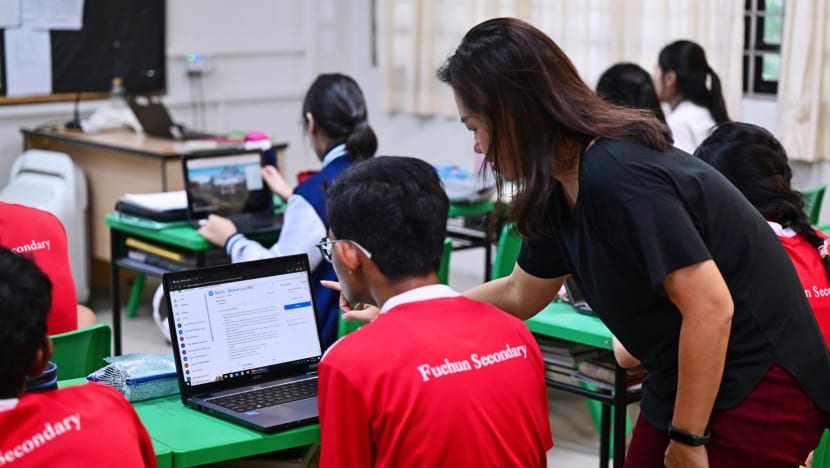
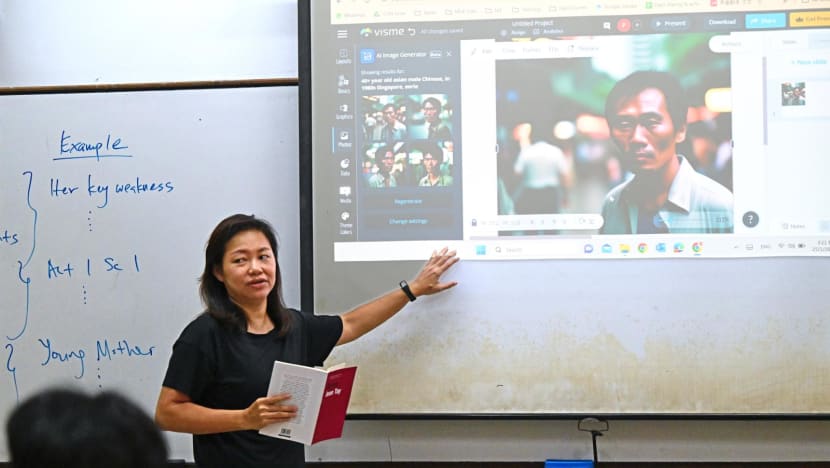
TURNING AI PITFALLS INTO A LESSON
At Fuchun Secondary School, Secondary 4 literature students were working on an essay question about the portrayal of Mother, a character in Boom by local playwright Jean Tay.
Their teacher Ms Pearlyn Lim said: “I know that many of you struggle with expressing yourself. So after you’ve typed it up, copy and paste the essay in ChatGPT.”
She encouraged students to ask the chatbot to rewrite their work in a clearer or better way.
“But you know, ChatGPT is not exactly reliable. So after it has generated or rewritten your responses in a clearer manner and you feel that there’s something wrong with it, raise your hand.”
After producing the description of Mother, Ms Lim encouraged students to use an AI image generator to create images of what they thought the younger and the older version of the character would look like.
This caused some chatter in the classroom. Students quickly learned that they had completely different perceptions of what Mother – a headstrong Asian matriarch – looked like in their heads. A pair of students quibbled over whether her hair should be up or down, to fit with her stern image.
Like the team at Manjusri Secondary, Ms Lim and her colleague Mr Kenneth Yee, who is an English teacher, first came across ChatGPT elsewhere. Mr Yee fed it some continuous writing questions and its answer was “near perfect”, he shared.
After realising that the responses produced by the chatbot were very American-centric, he brought it to the classroom to teach students how to use it.
“I got the students to generate a paragraph, and then from that paragraph, they were to modify it to a more local context, a more personalised version. They were to add certain vocabulary,” he continued, adding that students also used it like a spell-checking programme.
One of the very first few lessons was teaching them how to use ChatGPT and its limitations, he said.
“A lot of the first week of using it was just drilling into them, this is not your work, this is a tool, you have to use it properly.”
The students quickly learned that they “cannot use it wholesale” because they found errors in the responses.
“I was at the back of a class when the students found out that ChatGPT is not updated. Somebody asked which team won yesterday’s soccer game, and they gave the wrong team. The boy was so upset,” said Ms Lim with a chuckle.
Since the class is studying a local play, ChatGPT also does not have enough information to generate accurate analyses or essays about it. Students soon realised that the chatbot was making up parts of the story as it went along, she added.

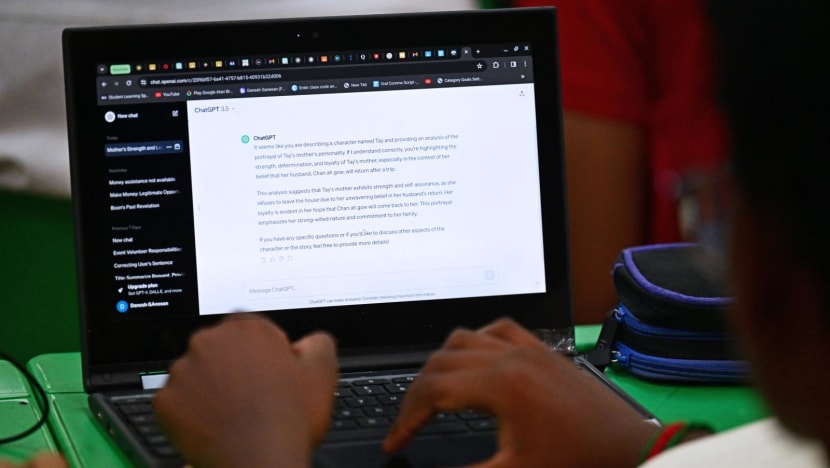
The first time she used ChatGPT in class, Ms Lim plopped a question from a class test into the chatbot and used it to generate an essay, much to the shock of her students.
“I accept that this is going to happen, and even if some of them don’t do it, as long as one person does it, it’s not fair. So I might as well show them that I know this is going to happen. Let me teach everybody how to do it.”
But Ms Lim believes ChatGPT can be a boon for inclusivity in the classroom. She recalled an incident where a student with a well-educated parent submitted a near-perfect essay and received high scores.
“I said, ‘This is very good and it doesn’t look like what you normally produce. Did you improve overnight?’”
The student then admitted that her mother had helped her with the essay, and Ms Lim acknowledged her work, encouraging her to understand what was good about the essay.
“There are people with parents like that, who are very helpful, they have the education, they have the time and resources,” she added.
“ChatGPT can now stand in as those parents, for children who don’t have such parents. So if you think about it, it provides resources where there were none.”














